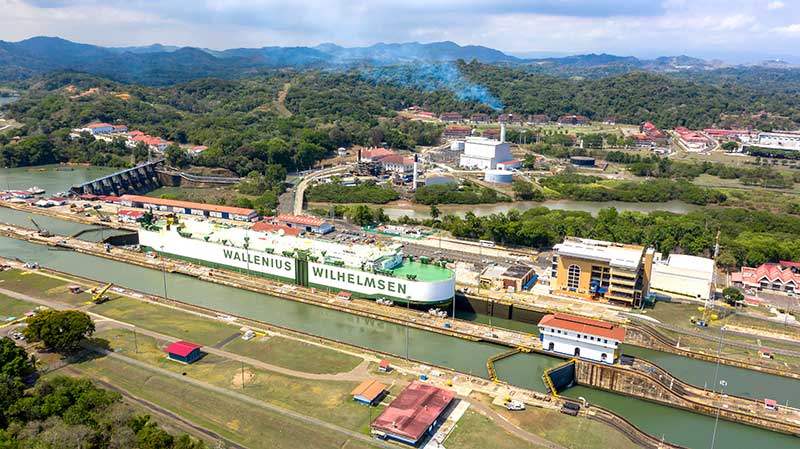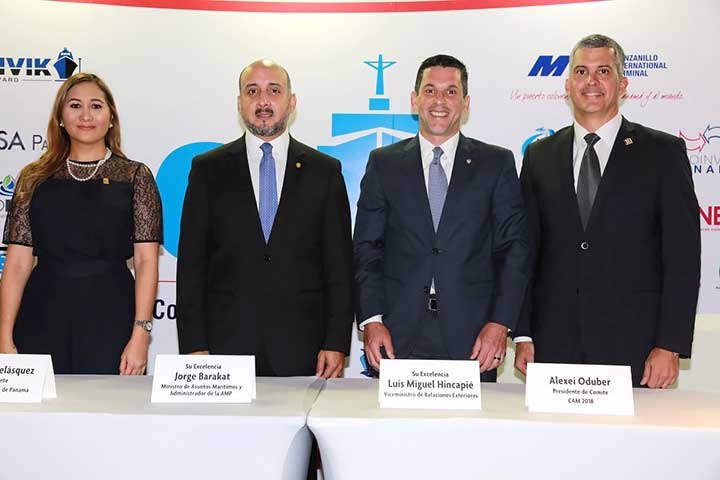The Relevance of a Reliable Canal
A shipping agent is in charge of facilitating a ship to navigate from point A to point B, as defined by Alexei Oduber, Manager of GAC Panama.
A shipping agent is in charge of facilitating a ship to navigate from point A to point B, as defined by Alexei Oduber, Manager of GAC Panama. The business is to do it faster, safer and in the cheapest way possible. With 30 years of experience in the management of maritime transport, and above all, as a Panamanian, Oduber talks about the Panama route.
What is the relevance of the Panama Canal in the country’s current situation?
Panamanians must understand the relevance of defending it from other routes. This geographical position requires us to be responsible. Watch over this route and maximize all the opportunities that we can. Panama has done a good job in defending its Canal from commercial and political interests.
When I talk to young people, I explain that they don’t have to be ship captains or chief engineers, they can work as occupational health specialists, welders, lawyers or maritime accountants… they all have a piece of the puzzle. Not everything has to be directly linked to the Canal.
However, it must also be a part that helps increase the culture. Everyone is important: those who sell cars, those who sell books, teachers … Panama must raise the rest of its economy to the Canal, it should not be the Canal cascading down. We have to elevate the rest and offer innovation in the services we offer as a country.

In this internal view, we have undergone a remarkable development. From 1914 to 2021, the country acquired its institutions, its sovereignty, and its reputation. How are we seen abroad today?
The Panama Canal’s main characteristic abroad is reliability. We are an efficient and predictable passage. The Canal does an excellent job in coordinating and transiting ships, but the real challenge is in predicting how many ships will pass through on a given day six months from now. If we could do this with a small margin of error, we would be maximizing the Canal’s capacity. Very precise mathematics are used to calculate the number of ships that will not arrive, those that arrive unannounced, or ships that may have changes in their itinerary.
Additionally, the Canal has learned to listen to its customers. I remember in the late 1990s, a conversation between the Canal and a customer consisted of a yes or no. Today this has changed a lot, and for the better.
Why are forecasts so important?
The industry we serve can be divided into two large blocks: those who transit regularly and those who do not. For the regulars, the Canal is part of their equation and [transit schedulers] can handle a high demand of unscheduled ships that will increase transit time through the waterway. For the other group, which moves commodities that do not have projection capacity, its variations have a stronger impact.
From your perspective, what are the prospects for Canal transit growth in the short term?
Water. All my calls with clients start like this: “Did it rain or not?”, because they understand how critical water is for their transit. If we can solve the water availability issue, we will grow physically, regardless of the technological solution that is chosen.
The user who has been paying between $15,000 and $50,000 in freshwater surcharges was told that the increase was to find this solution, and they want to know what is going on. Certainly, there are regulations that protect good contract performance. I’m not talking about accelerating this, but customers need to know how we plan for the next 12- to 15-years. They want to know how many more ships can transit the Canal. Without solving the water issue, we will be unable to grow.

What makes a client prefer to use the Panama route?
As a shipping agent, I have to “sell” our route. We make it difficult to opt for another option because I can project less than ten hours for a transit. Hull cleaning, crew changes, spare parts, class inspections can be done, and all this makes the mere transit more interesting.
On the other hand, size matters. It is impossible to sell a ship that does not fit through the Canal. This is where we see the impact of the Expanded Canal, in customers using Neopanamax vessels for transshipments. Each type of ship is a different sell.
When you have a product like the Canal, you tend to feel comfortable, at ease. I strive to make sure that the people in my office never lose their enthusiasm. Let them recognize what happened today, but also let them know that tomorrow is a new day with potential challenges, because the competition is there: Suez, the U.S. intermodal system… all of them competing for the use of their routes.
When the Ever Given ran aground in the Suez Canal, we did not celebrate – no one did – but we must explain the measures that are taken in the Canal to protect us from similar events. We are not exempt from disasters, but we have a high level of safety that helps us minimize risks.
The GAC Group is a maritime, logistics and transportation services provider with operations in 50 countries. With Swedish roots and based in Dubai, GAC is formed by approximately 8,000 employees in 300 offices around the world. In Panama, they offer maritime services to vessels calling at Panamanian ports or transiting the Panama Canal.
What are the main commodities shipped through the Panama Canal?
This would have been a simpler answer before the pandemic. Now we see that the traditional storage centers are very vulnerable, and that is why logistics companies like Amazon, or retailers like Apple, are restructuring distribution centers closer to their customers.
Liquefied natural gas has stimulated the route from the U.S. Gulf Coast to Southeast Asia. Furthermore, the traditional containerized import supply from Southeast Asia to the U.S. East Coast remains relevant.
The west coast of South America is developing the movement of raw materials, fertilizers, metals, which are products that are going to be essential in the reconstruction of many things.
What has become evident since the pandemic?
One of the vulnerabilities that has become evident is how unprepared the industry was to help the seafarers, who are workers who have been on board for up to 18 months. Additionally, there was an increase in chronic illnesses. With regard to office work, we realized that, with remote work, we could work from anywhere; this challenged our culture, but we did very well. It had been two years since the company migrated to digital telecommuting platforms, and when the pandemic hit, there was barely any decrease in productivity.
What does the maritime industry represent for humanity in the 21st century?
For most, lack of understanding. It is a fantastic operation, but hard to explain. It is assumed that things get to you because they just do. My personal experience with my friends is that I have been explaining what I do for 30 years, and they still ask me, “What is it that you do with ships?” In the maritime industry, every day is the same and every day is different. In this industry you take advantage of learning opportunities in the moment, and you never leave anything for later, because there won’t be time later.